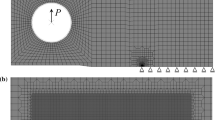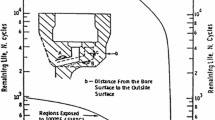Abstract
Crack growth behaviour under creep-fatigue conditions in Udimet 700 has been studied, and the crack growth data were analysed in terms of the stress intensity factor as well as theJ-integral parameter. Crack growth behaviour is shown to depend on the initial stress intensity level and the duration of hold-time at the peak load. For stress intensities that are lower than the threshold stress intensity for creep crack growth, the crack growth rate decreases with increase in hold time even on a cycle basis, da/dN, to the extent that complete crack arrest could occur at prolonged hold times. This beneficial creep-fatigue interaction is attributed to the stress relaxation due to creep. For stress intensities greater than the threshold stress intensity for creep crack growth, the growth rate on a cycle basis increases with increase in hold time. For the conditions where there is no crack arrest, the crack growth appears to be essentially cycle-dependent in the low stress intensity range and time-dependent in the high stress intensity range. Both the stress intensity factor and theJ-integral are shown to be valid only in a limited range of loads and hold-times where crack growth rate increases continuously.
Similar content being viewed by others
References
E. Krempl andB. M. Wundt, ASTM STP 489 (1971).
E. G. Ellison andD. Walton, International Conference on Creep and Fatigue in Elevated Temperature Applications (Institution of Mechanical Engineers, London, 1973).
W. R. Corwin, Oak Ridge National Laboratory Report, ORNL-5117 (1976) p. 46.
P. Shahinian,Trans. ASME 98 (1976) 166.
L. A. James,Nuclear Technol. 16 (1972) 521.
P. Shahinian, H. H. Smith andH. E. Watson, ASTM STP 520 (1973) p. 387.
D. J. Michel andH. H. Smith, “Creep-Fatigue Interaction”, ASME MPC Symposium (1976) p. 391.
P. Shahinian andK. Sadananda”, Creep-Fatigue Interaction”, ASME MPC Symposium (1976) p. 365.
T. Ohmura, R. M. Pelloux andN. J. Grant, “Engineering Fracture Mechanics”, Vol. 5 (1973) p. 909.
H. G. Popp andA. Coles, Proceedings of the Air Force Conference on Fatigue and Fracture of Aircraft Structures and Materials, AFFDL TR-70-144 (1970) p. 71.
K. Sadananda andP. Shahinian,Met. Trans. A 9A (1978) 79.
Idem, Eng. Fracture Mech. (in press).
C. H. Wells andC. P. Sullivan, ASTM STP459 (1969) p. 59.
E. G. Ellison andC. P. Sullivan,Trans. Quart. ASM 60 (1967) 88.
1974 Annual Book of ASTM Standards, Part II (1974) p. 432.
W. K. Wilson,Eng. Fracture Mech. 2 (1970) 169.
P. Shahinian,Nuclear Technol. 38 (1978) 415.
J. R. Rice, “Fracture —An Advanced Treatise”, edited by H. Liebowitz, Vol. 2 (Academic Press, New York, 1968).
P. Shahinian, unpublished results.
Author information
Authors and Affiliations
Rights and permissions
About this article
Cite this article
Sadananda, K., Shahinian, P. Hold-time effects on high temperature fatigue crack growth in Udimet 700. J Mater Sci 13, 2347–2357 (1978). https://doi.org/10.1007/BF00808048
Received:
Accepted:
Published:
Issue Date:
DOI: https://doi.org/10.1007/BF00808048




